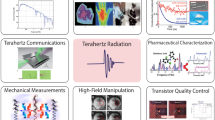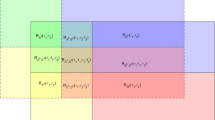Abstract
In this paper, we propose a novel method employing subspace fitting principle for DOA estimation of noncircular signal based on the sparse representation technology. The proposed method combines the signal information contained in both the covariance and elliptic covariance matrix of the received data matrix. We use the eigenvalue decomposition of the extended covariance to obtain the signal eigenvectors, and represent the steering vector on overcomplete basis subject to sparse constraint in subspace fitting method. After casting multiple dimensional optimization problem of the classical subspace fitting method as a sparse reconstruction problem, we use L1-norm penalty for sparsity, and optimization by the second order cone programming framework to obtain the DOA estimates. The proposed method can be used in arbitrary array configuration. Compared with the existing algorithms, the simulation results show that the proposed method has better performance in low SNR. Compared with L1-SVD, the proposed method also own better resolution probability.






Similar content being viewed by others
References
Barabell, A. J. (1983). Improving the resolution performance of eigenstructure-based direction-finding algorithms. ICASSP, 8, 336–339.
Rao, B. D., & Hari, K. V. (1989). Performance analysis of Root-MUSIC. IEEE Transaction on Acoustics, Speech and Signal Processing, 37(12), 1939–1949.
Ren, Q. S., & Willis, A. J. (1997). Fast Root-MUSIC algorithm. IEE Electronics Letters, 33(6), 450–451.
Roy, R., Paulraj, A., & Kailath, T. (1989). ESPRIT-estimation of signal parameters via rotational invariance techniques. IEEE Transaction on Acoustics, Speech and Signal Processing, 37, 984–995.
Shahbazpanahi, S., & Valaee, S. (2001). Distributed source localization using ESPRIT algorithm. IEEE Transaction on Signal Processing, 49, 2169–2178.
Ottersten, B., & Viberg, M. (1991). Sensor array processing based on subspace fitting IEEE Transaction on. Signal Processing, 39(5), 1110–1121.
Malioutov, D., Cetin, M., & Willsky, A. S. (2005). A sparse signal reconstruction perspective for source localization with sensor arrays. IEEE Transaction on Signal Processing, 53(8), 3010–3022.
Hyder, M. M., & Mahata, K. (2010). Direction-of-arrival estimation using a mixed L2,0 norm approximation. IEEE Transaction on Signal Processing, 58(9), 4646–4655.
He, Z. Q., Liu, Q. H., Jin, L. N., et al. (2013). Low complexity method for DOA estimation using array covariance matrix sparse representation. Electronics Letters, 49(3), 228–230.
Stoica, P., Babu, P., & Li, J. (2011). SPICE: A sparse covariance-based estimation method for array processing. IEEE Transaction on Signal Processing, 59(2), 629–638.
Abeida, H., Zhang, Q., Li, J., et al. (2013). Iterative sparse asymptotic minimum variance based approaches for array processing. IEEE Transaction on Signal Processing, 61(4), 933–944.
Gounon, P., Adnet, C., & Galy, J. (1998). Localization angulaire de signaux non circulaires. Traitement du Signal, 15(1), 17–23. 1998.
Chlarge, P., Wang, Y., & Saillard, J. (2001). A Root-MUSIC algorithm for non circular sources, In IEEE international conference acoustics, speech, and signal processing (pp. 7–11). Salt Lake City, UT.
Chlarge, P., Wang, Y., & Saillard, J. (2001). A non-circular sources direction finding method using polynomial rooting. Signal Processing, 81, 1765–1770.
Abeida, H., & Delmas, J. (2006). MUSIC-like estimation of direction of arrival for noncircular sources. IEEE Transaction on Signal Processing, 54(7), 2678–2690.
Gao, F., Wang, Y., & Nallanathan, A. (2006). Improved MUSIC by exploiting both real and complex sources. Washington, DC: MILCOM.
Zoubir, A., Charge, P., & Wang, Y. (2003). Non circular sources localization with ESPRIT. In Proceedings of European conference on wireless technology (ECWT 2003). Munich, Germany.
Liu, Z., Huang, Z., Zhou, Y., et al. (2012). Direction-of-arrival estimation of noncircular signals via sparse representation. IEEE Transactions on Aerospace and Electronic Systems, 48(3), 2690–2698.
Wong, K. M., Reilly, J. P., Wu, Q., et al. (1992). Estimation of the directions of arrival of signals in unknown correlated noise. I. The MAP approach and its implementation. IEEE Transaction on Signal Processing, 40(8), 2007–2017.
Stoica, P., & Sharman, K. C. (1990). Novel eigenanalysis method for direction estimation. IEE Proceedings F (Radar and Signal Processing), 137(1), 19–26.
Steiglitz, K., & McBride, L. (1965). A technique for identification of linear system. IEEE Transaction on Automatic Control, 10(4), 461–464.
Cadzow, J. A. (1990). Multiple source location-the signal subspace approach. IEEE Transaction on Acoustics, Speech and Signal Processing, 38(7), 1110–1125.
Tropp, J. A., & Wright, S. J. (2010). Computational methods for sparse solution of linear inverse problems. Proceedings of the IEEE., 98(6), 948–958.
Grant, M., & Boyd, S. (2010). CVX: MATLAB software for disciplined convex programming. Online available: http://cvxr.com/cvx.
Sturm, J. S. (2010). Using SeDuMi 1.02, a Matlab toolbox for optimization over symmetric cones. Online available: http://fewcal.kub.nl/strum
Jeffries, D. J., & Farrier, D. R. (1985). Asymptotic results for eigenvector methods. IEE Proceedings F (Communications, Radar and Signal Processing), 132(7), 589–594.
Viberg, M., Ottersten, B., & Kailath, T. (1991). Detection and estimation in sensor arrays using weighted subspace fitting. IEEE Transaction on Signal Processing, 39(11), 2436–2449.
Acknowledgments
This research was supported by the National Natural Science Foundation of China under Grant No. 61301155 and 61176025, and the Fundamental Research Funds for the Central Universities Project No. ZYGX2012J003, for which the authors would like to express their thanks. The authors also wish to thank the anonymous reviewers for their helpful and constructive comments and suggestions.
Author information
Authors and Affiliations
Corresponding author
Rights and permissions
About this article
Cite this article
Yang, X., Li, G. & Zheng, Z. DOA Estimation of Noncircular Signal Based on Sparse Representation. Wireless Pers Commun 82, 2363–2375 (2015). https://doi.org/10.1007/s11277-015-2352-z
Published:
Issue Date:
DOI: https://doi.org/10.1007/s11277-015-2352-z




